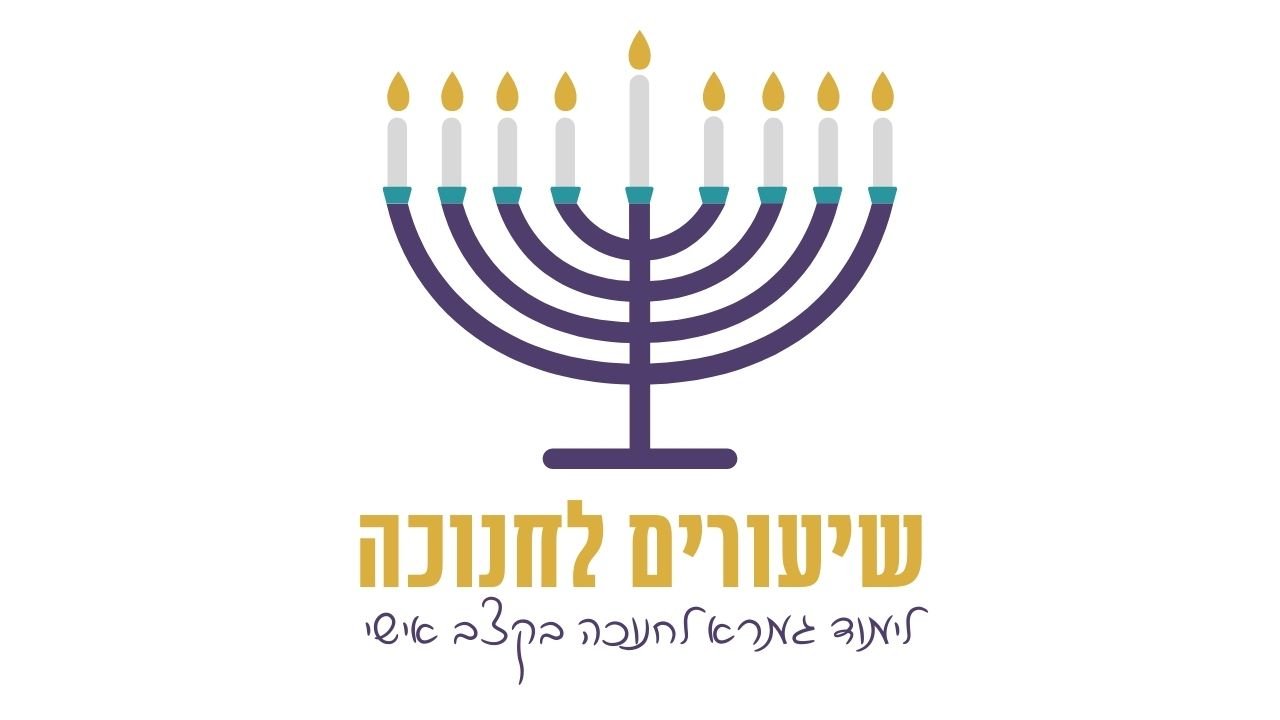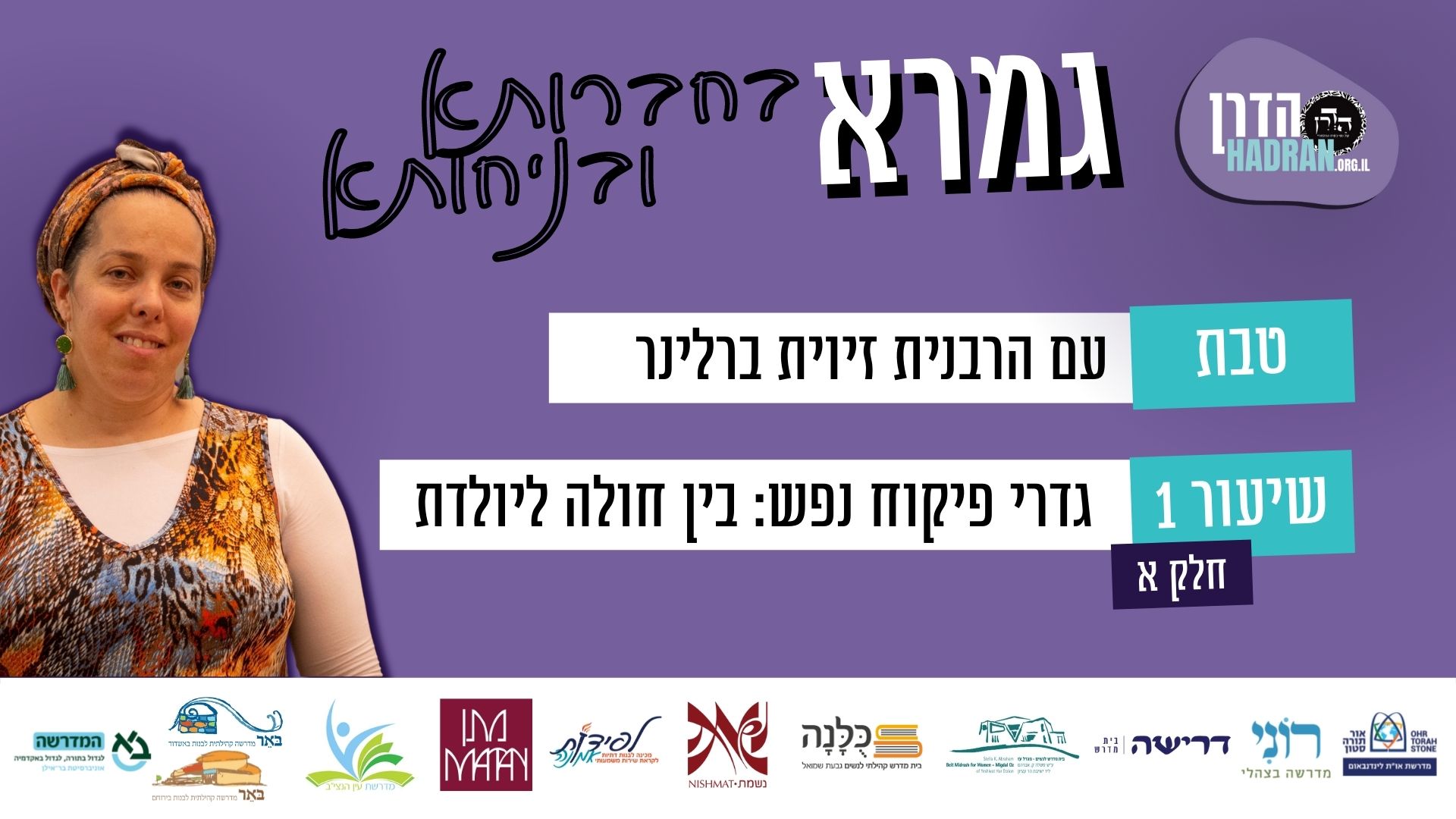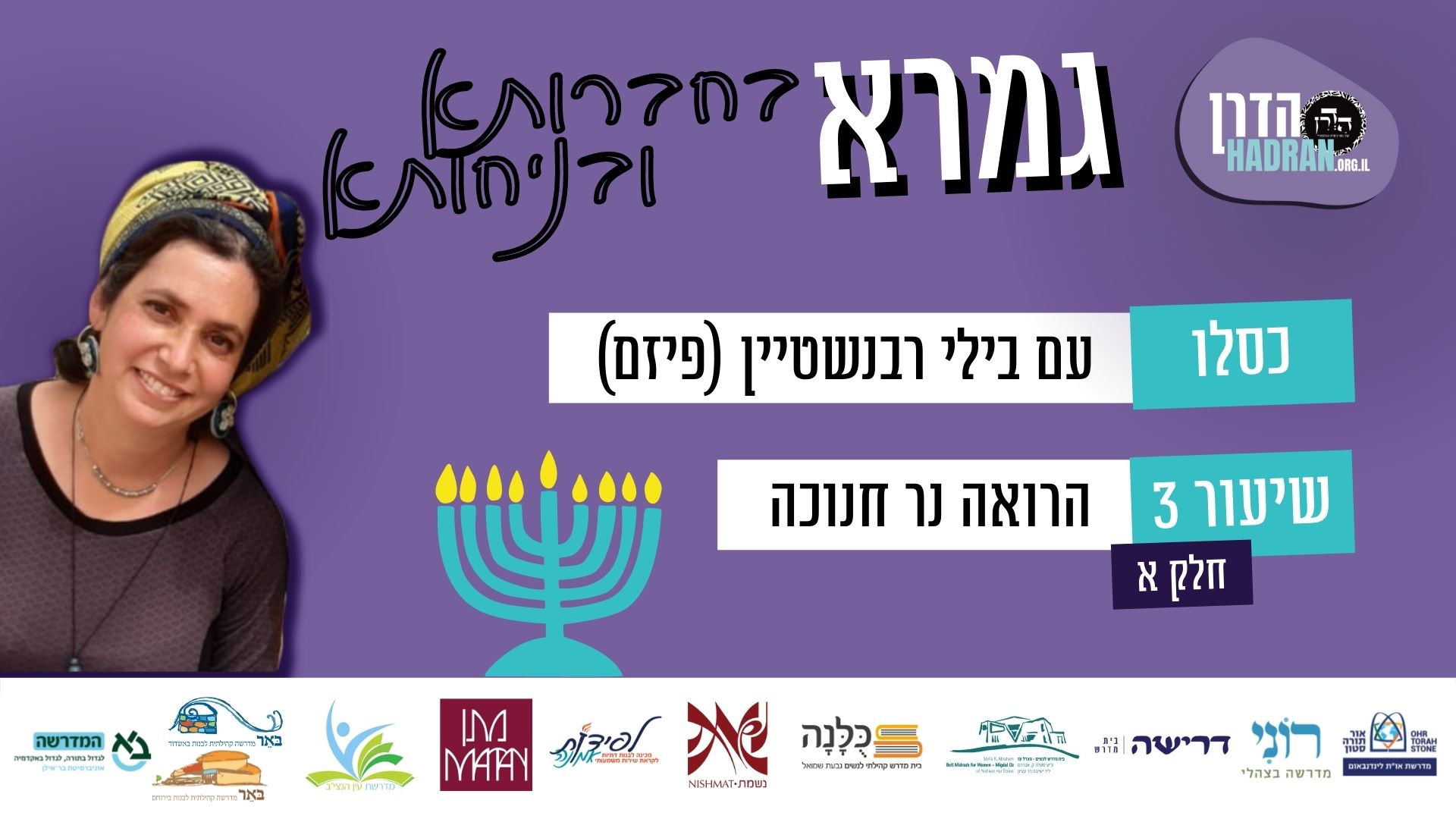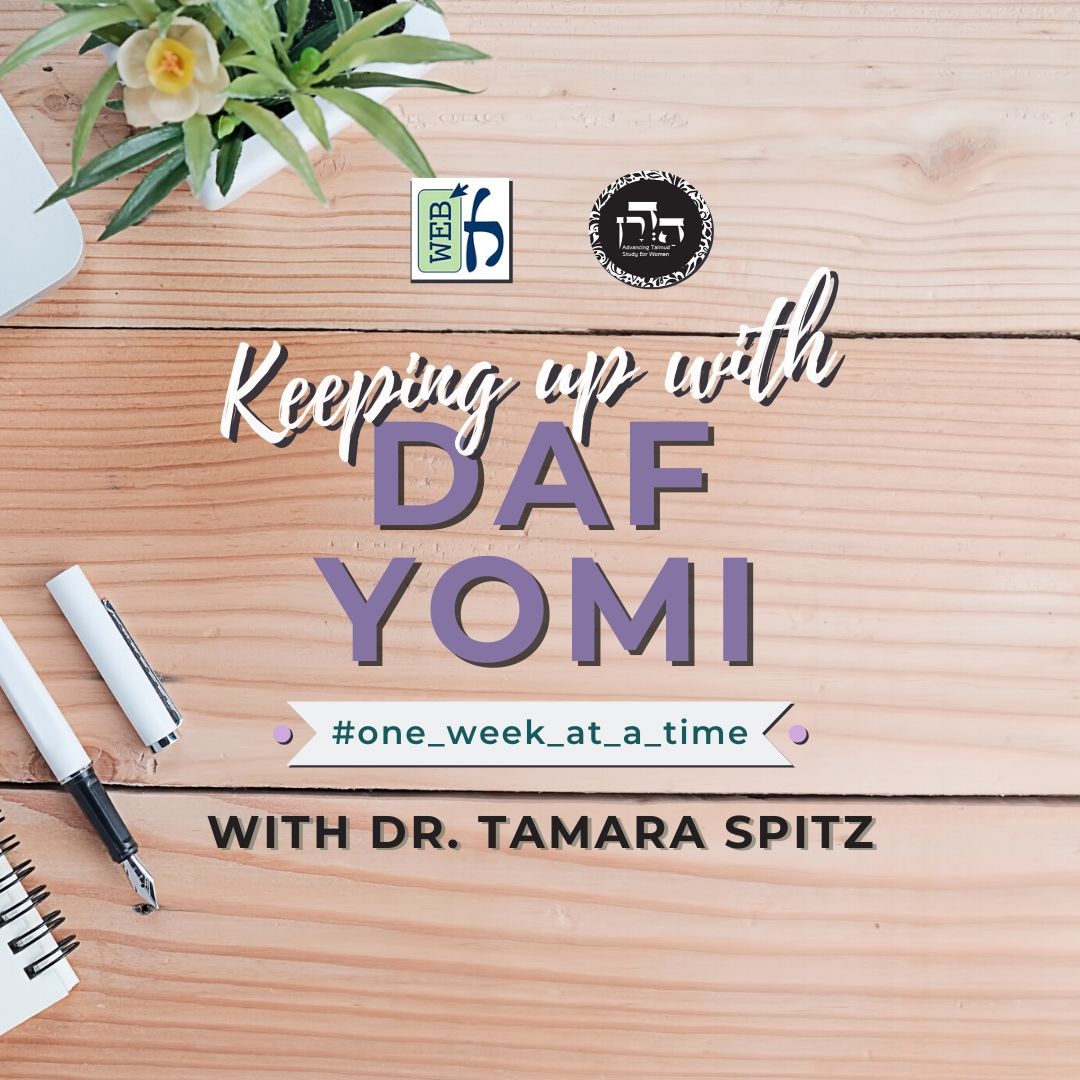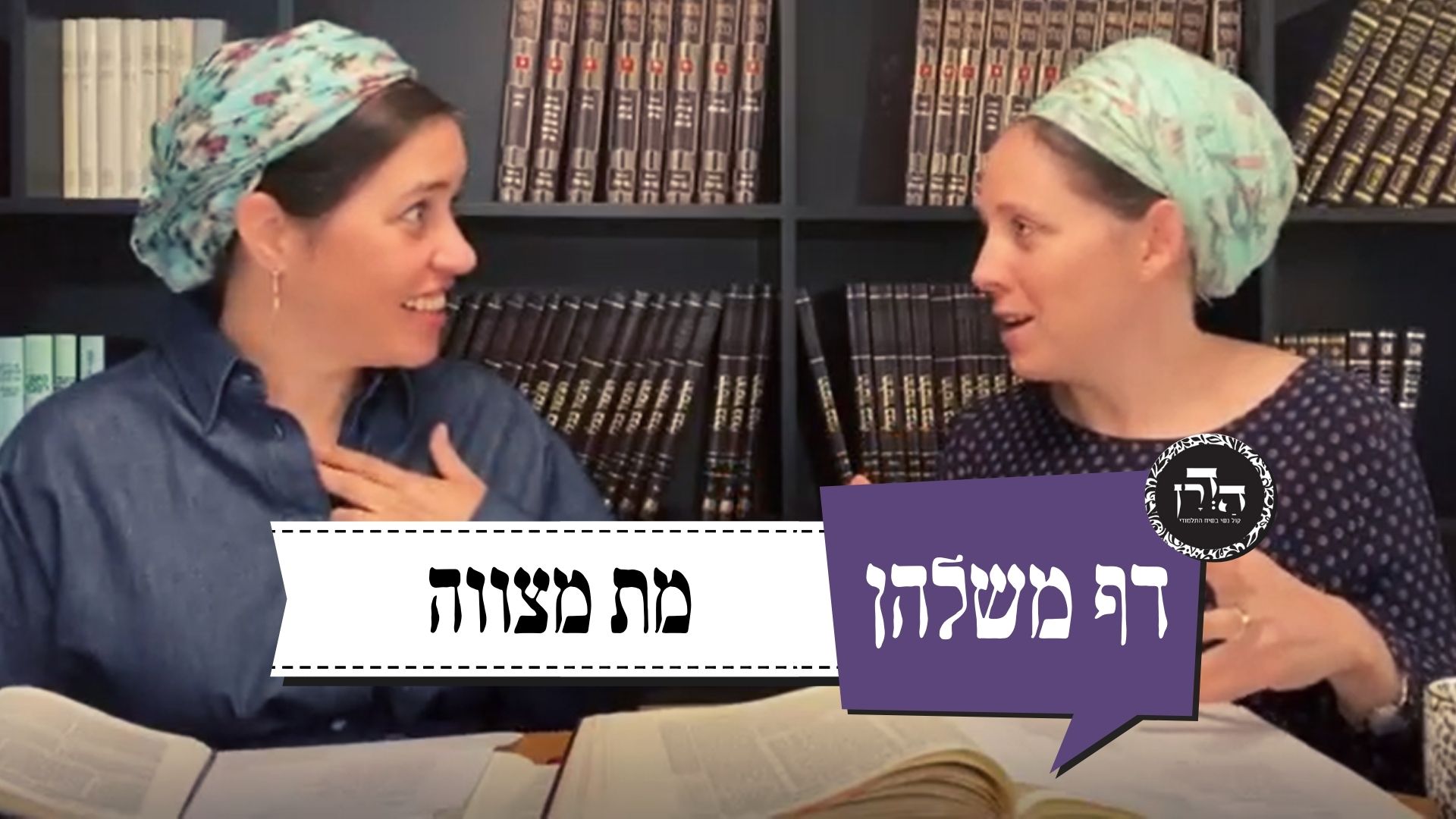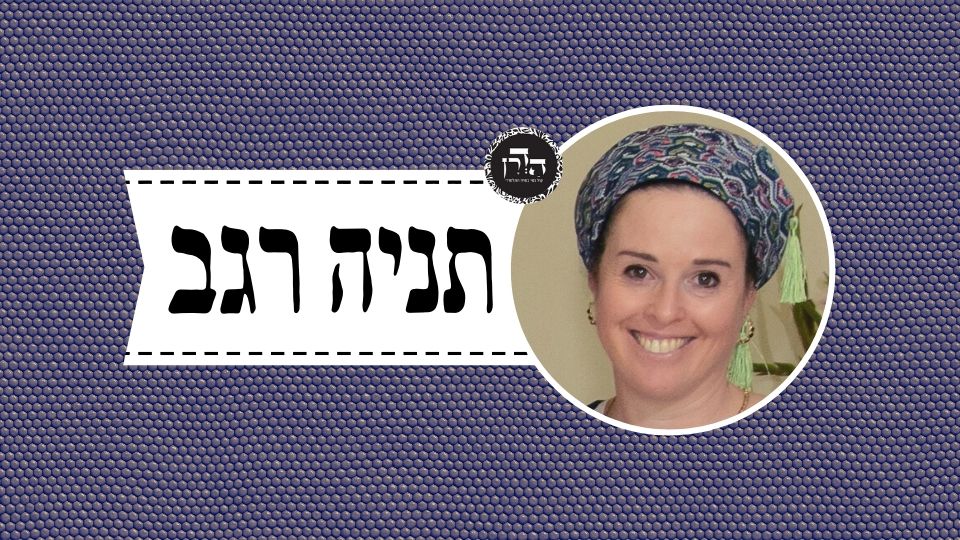הגמרא דורשת כל מיני דברים לגבי טומאה בנוצת עזים – באיזה סוג של דברים זה שייך והאם מקבלים טומאה בשיעור כל שהוא. עם איזה דברים מותר לאשה לצאת בשבת? יש דברים שמותרים בחצר אבל לא לרשות הרבים ויש דברים שאסורים גם בחצר שמא תצא לרשות הרבים – אבל יש מחלקות לגבי דבר זה. למה נשים יוצאות עם תכשיטים למרות שמפשט הדברים בגמרא נראה שאסור?
הלימוד השבוע מוקדש ע”י רוברט ופאולה כהן לע”נ יוסף בן משה הכהן ז”ל. יוסף היה חזן שאהב מאוד לשיר, עבד קשה בחייו והיה מאוד מסור למשפחתו ולקהילה.
רוצה להקדיש שיעור?

כלים
הלימוד השבוע מוקדש ע”י רוברט ופאולה כהן לע”נ יוסף בן משה הכהן ז”ל. יוסף היה חזן שאהב מאוד לשיר, עבד קשה בחייו והיה מאוד מסור למשפחתו ולקהילה.
כלים
העמקה
רוצה להבין מה באמת קורה מתחת לפני השטח של הסוגיה?
שיעורים, פודקאסטים והרחבות של מיטב המורות שלנו יפתחו לך עוד זוויות וכיווני חשיבה.
חדשה בלימוד הגמרא?
זה הדף הראשון שלך? איזו התרגשות עצומה! יש לנו בדיוק את התכנים והכלים שיעזרו לך לעשות את הצעדים הראשונים ללמידה בקצב וברמה שלך, כך תוכלי להרגיש בנוח גם בתוך הסוגיות המורכבות ומאתגרות.
פסיפס הלומדות שלנו
גלי את קהילת הלומדות שלנו, מגוון נשים, רקעים וסיפורים. כולן חלק מתנועה ומסע מרגש ועוצמתי.
שבת סד
״כְּלִי״ ״כְּלִי״ מֵהָתָם.
from the word vessel written there, with regard to the halakhot of ritual impurity imparted by a corpse, and the word vessel written with regard to the halakhot of other impurities.
מוּסָף שַׂק עַל הַבֶּגֶד שֶׁטָּמֵא מִשּׁוּם אָרִיג. אַטּוּ בֶּגֶד לָאו אָרִיג הוּא?! הָכִי קָאָמַר: מוּסָף שַׂק עַל הַבֶּגֶד, אַף עַל פִּי שֶׁאֵינוֹ אָרִיג — טָמֵא. לְמַאי חֲזֵי? אָמַר רַבִּי יוֹחָנָן: שֶׁכֵּן עָנִי קוֹלֵעַ שָׁלֹשׁ נִימִין וְתוֹלָה בְּצַוַּאר בִּתּוֹ.
It was taught in the baraita that a sack is added to the category of “garment”; it too is ritually impure due to woven fabric. The Gemara asks: Is that to say that a garment is not a woven fabric? Rather, the statement should be emended and say as follows: A sack made from goat hair is added to the category of garment; even though it is not woven it can nevertheless become ritually impure. The Gemara asks: For what is a garment made of unwoven goat hair suitable? Rabbi Yoḥanan said: Since a poor person occasionally braids three goat hairs and hangs it on his daughter’s neck as an ornament.
תָּנוּ רַבָּנַן: ״שָׂק״ — אֵין לִי אֶלָּא שַׂק, מִנַּיִין לְרַבּוֹת אֶת הַקִּילְקְלִי וְאֶת הַחֲבָק — תַּלְמוּד לוֹמַר: ״אוֹ שָׂק״. יָכוֹל שֶׁאֲנִי מְרַבֶּה אֶת הַחֲבָלִים וְאֶת הַמְּשִׁיחוֹת — תַּלְמוּד לוֹמַר: ״שָׂק״. מָה שַׂק טְוִוי וְאָרִיג — אַף כֹּל טְוִוי וְאָרִיג.
The Sages taught a detailed halakhic exposition of that verse in a different baraita. From the fact that the verse mentioned sack, I have only derived that a whole sack can become ritually impure. From where is it derived to include even reins [kilkeli] and a saddle band fastened under the horse’s belly in the category of those objects that can become ritually impure? The verse states: “Or sack”; “or” teaches that the verse is referring to items similar to a sack as well. I might have thought, on that basis, that I should include even the ropes and measuring cords. The verse states: “Sack,” just as a sack is spun and woven, so too, everything that is spun and woven can become ritually impure. Ropes and measuring cords are not made from spun threads, and they are certainly not woven.
הֲרֵי הוּא אוֹמֵר בְּמֵת: ״וְכׇל כְּלִי עוֹר וְכׇל מַעֲשֵׂה עִזִּים וְגוֹ׳ תִּתְחַטָּאוּ״ — לְרַבּוֹת הַקִּילְקְלִי וְאֶת הַחֲבָק.
The baraita continues: Now, it says with regard to the halakhot of ritual impurity imparted by a corpse: “And every garment and all that is made of skins and all work of goats’ hair and all things made of wood you shall purify” (Numbers 31:20). This verse comes to include reins and the band under the horse’s belly within the category of: All work of goats’ hair. They too can become ritually impure.
יָכוֹל שֶׁאֲנִי מְרַבֶּה אֶת הַחֲבָלִים וְאֶת הַמְּשִׁיחוֹת? וְדִין הוּא: טִימֵּא בַּשֶּׁרֶץ, וְטִימֵּא בַּמֵּת. מָה כְּשֶׁטִּימֵּא בַּשֶּׁרֶץ — לֹא טִימֵּא אֶלָּא טְוִוי וְאָרִיג, אַף כְּשֶׁטִּימֵּא בַּמֵּת — לֹא טִימֵּא אֶלָּא טְוִוי וְאָרִיג.
I might have thought that I would include even the ropes and thin cords in this category. The Gemara begins with a logical analysis. And it may be inferred logically to the contrary, that a rope cannot become impure. The verse deemed impure an object that came in contact with a creeping animal, and it deemed impure an object that came in contact with a corpse. Just as when it rendered an object impure from contact with a creeping animal it only rendered impure objects spun and woven, as stated above; so too, when it rendered impure an object from contact with a corpse, it only rendered impure objects spun and woven.
הֵן אִם הֵיקֵל בְּטוּמְאַת שֶׁרֶץ שֶׁהִיא קַלָּה, נָקֵיל בְּטוּמְאַת הַמֵּת שֶׁהִיא חֲמוּרָה?! — תַּלְמוּד לוֹמַר ״בֶּגֶד״ וָ״עוֹר״ ״בֶּגֶד״ וָ״עוֹר״ לִגְזֵירָה שָׁוָה.
There is room to distinguish: Are these indeed comparable? If the Torah was lenient with regard to the ritual impurity of an object that came in contact with a creeping animal, which is a less severe form of impurity, saying that ropes do not become impure from contact with that form of ritual impurity, will we be lenient with regard to ritual impurity imparted by a corpse, which is more severe? Perhaps, since impurity imparted by a corpse is more severe, even objects not woven and spun, e.g., ropes, become ritually impure from contact with it. Therefore, the verse states garment and leather, garment and leather to establish a verbal analogy.
נֶאֱמַר ״בֶּגֶד״ וָ״עוֹר״ בְּשֶׁרֶץ וְנֶאֱמַר ״בֶּגֶד״ וָ״עוֹר״ בְּמֵת. מָה בֶּגֶד וָעוֹר הָאָמוּר בְּשֶׁרֶץ — לֹא טִימֵּא אֶלָּא טְוִוי וְאָרִיג, אַף בֶּגֶד וָעוֹר הָאָמוּר בְּמֵת — לֹא טִימֵּא אֶלָּא טְוִוי וְאָרִיג.
The term garment and leather is stated with regard to ritual impurity imparted by a creeping animal: “And whatever any of them falls upon when they are dead will be impure whether it be any vessel of wood, or a garment, or leather, or sack, whatever vessel it be with which any work is done it must be put into water and it will be impure until evening, then it will be clean” (Leviticus 11:32). And garment and leather is stated with regard to ritual impurity imparted by a corpse. Just as garment and leather stated with regard to a creeping animal only rendered impure objects that are spun and woven, so too, garment and leather stated with regard to a corpse only rendered impure objects that are spun and woven.
וּמָה בֶּגֶד וָעוֹר הָאָמוּר בְּמֵת — טִמֵּא כׇּל מַעֲשֵׂה עִזִּים, אַף בֶּגֶד וָעוֹר הָאָמוּר בְּשֶׁרֶץ — טִמֵּא כׇּל מַעֲשֵׂה עִזִּים.
Utilizing the same verbal analogy, one could say: And just as garment and leather stated with regard to a corpse rendered impure any object that is the work of goats’ hair, so too, garment and leather stated with regard to a creeping animal rendered impure any object that is the work of goats’ hair.
אֵין לִי אֶלָּא דָּבָר הַבָּא מִן הָעִזִּים, מִנַּיִין לְרַבּוֹת דָּבָר הַבָּא מִזְּנַב הַסּוּס וּמִזְּנַב הַפָּרָה? — תַּלְמוּד לוֹמַר: ״אוֹ שָׂק״.
I have only derived from this verbal analogy that an object that comes from goats can become ritually impure; from where do I derive to include an item that comes from a horse’s tail or from a cow’s tail? The verse states: Or a sack, and anything like a sack, i.e., these other items as well.
וְהָא אַפֵּיקְתֵּיהּ לְקִילְקְלִי וַחֲבָק?
The Gemara asks: Didn’t you already derive ritual impurity with regard to reins and a saddle band from this verse? How can ritual impurity for items that come from a horse’s tail and a cow’s tail be derived from the same verse?
הָנֵי מִילֵּי מִקַּמֵּי דְּתֵיתֵי גְּזֵירָה שָׁוָה, הַשְׁתָּא דְּאָתְיָא גְּזֵירָה שָׁוָה אִיַּיתַּר לֵיהּ.
The Gemara answers: That applies only before the verbal analogy was cited; now that the verbal analogy was cited, the verse is rendered extraneous. The fact that any item that falls in the category of: “And all work of goats’ hair,” can become ritually impure is derived from the verbal analogy. Reins and a saddle bands are included in the category of work of goats’ hair. Therefore, they need not be derived from that phrase. Consequently, a different halakha can be derived from that extraneous phrase: Objects that come from a horse’s tail or a cow’s tail can become ritually impure.
וְאֵין לִי אֶלָּא בְּשֶׁרֶץ, בְּטוּמְאַת מֵת מִנַּיִין?
The baraita continues: And I have derived that an object made from a horse’s tail can become impure only with regard to a creeping animal; however, with regard to a corpse, from where is this derived?
וְדִין הוּא: טִימֵּא בְּמֵת וְטִימֵּא בְּשֶׁרֶץ. מָה כְּשֶׁטִּימֵּא בְּשֶׁרֶץ — עָשָׂה דָּבָר הַבָּא מִזְּנַב הַסּוּס וּמִזְּנַב הַפָּרָה כְּמַעֲשֵׂה עִזִּים, אַף כְּשֶׁטִּימֵּא בְּמֵת — עָשָׂה דָּבָר הַבָּא מִזְּנַב הַסּוּס וּמִזְּנַב הַפָּרָה כְּמַעֲשֵׂה עִזִּים.
The Gemara begins with a logical analysis. And it may be inferred logically that this is so. The Torah rendered impure a sack that came into contact with a corpse and rendered impure a sack that came into contact with a creeping animal. Just as when the Torah rendered items that came into contact with a creeping animal impure it made the legal status of that which comes from a horse’s tail and a cow’s tail equal to the legal status of that which is made from goats’ hair, i.e., that it contracts ritual impurity, so too when the Torah rendered impure items that came into contact with a corpse, it made the legal status of that which comes from a horse’s tail and a cow’s tail equal to the legal status of that which is made from goats’ hair.
הֵן אִם רִיבָּה בְּטוּמְאַת עֶרֶב שֶׁהִיא מְרוּבָּה, נְרַבֶּה בְּטוּמְאַת שִׁבְעָה שֶׁהִיא מוּעֶטֶת?!
The Gemara rejects this: Are these indeed comparable? If the verse added additional objects to the category of ritual impurity that lasts until nightfall, e.g., the impurity imparted by a creeping animal, which is extensive, will we add additional objects to the category of ritual impurity that lasts for seven days, which is limited to the case of impurity from a corpse? The fact that items made of a horse’s tail or a cow’s tail are added to the already broad category of ritual impurity that lasts until nightfall is not necessarily an indication that they are to be added to the category of ritual impurity that lasts seven days.
תַּלְמוּד לוֹמַר: ״בֶּגֶד״ וָ״עוֹר״ ״בֶּגֶד״ וָ״עוֹר״ לִגְזֵירָה שָׁוָה. נֶאֱמַר ״בֶּגֶד״ וָ״עוֹר״ בְּשֶׁרֶץ, וְנֶאֱמַר ״בֶּגֶד״ וָ״עוֹר״ בְּמֵת. מָה ״בֶּגֶד״ וָ״עוֹר״ הָאָמוּר בְּשֶׁרֶץ — עָשָׂה דָּבָר הַבָּא מִזְּנַב הַסּוּס וּמִזְּנַב הַפָּרָה כְּמַעֲשֵׂה עִזִּים, אַף ״בֶּגֶד״ וָ״עוֹר״ הָאָמוּר בְּמֵת — עָשָׂה דָּבָר הַבָּא מִזְּנַב הַסּוּס וּמִזְּנַב הַפָּרָה כְּמַעֲשֵׂה עִזִּים.
The verse states: Garment and leather, garment and leather to establish a verbal analogy. Garment and leather is stated with regard to ritual impurity imparted by a creeping animal, and garment and leather is stated with regard to ritual impurity imparted by a corpse. Just as with regard to the garment and leather stated in the halakhot of a creeping animal the Torah rendered the legal status of an item made from a horse’s tail or a cow’s tail equal to the legal status of that which is made from goats’ hair, so too, with regard to the garment and leather stated in the halakhot of a corpse, the Torah rendered the legal status of an item made from a horse’s tail or a cow’s tail equal to the legal status of that which is made from goats’ hair.
וּמוּפְנֶה. דְּאִי לָאו מוּפְנֶה, אִיכָּא לְמִיפְרַךְ: מָה לְשֶׁרֶץ שֶׁכֵּן מְטַמֵּא בְּכַעֲדָשָׁה?!
The Gemara notes: And it must be that the words garment and leather are free. Those terms must be superfluous in their context. The Torah included those terms for the express purpose of establishing the verbal analogy. A verbal analogy that is based on otherwise extraneous terms cannot be logically refuted. Because if these terms are not free, the verbal analogy can be refuted: What is unique to a creeping animal? Its ritual impurity is stringent in that it renders objects ritually impure even by means of contact with a lentil-bulk of a creeping animal. That is not the case with regard to a corpse, which is less severe in that it renders objects ritually impure only by means of contact with an olive-bulk of a corpse. Unless the terms are free, the analogy can be refuted.
לָאיֵי אִפְּנוֹיֵי מוּפְנֵי. מִכְּדֵי שֶׁרֶץ אִיתַּקַּשׁ לְשִׁכְבַת זֶרַע, דִּכְתִיב: ״אִישׁ אֲשֶׁר תֵּצֵא מִמֶּנּוּ שִׁכְבַת זָרַע״, וּסְמִיךְ לֵיהּ: ״אִישׁ אֲשֶׁר יִגַּע בְּכׇל שֶׁרֶץ״, וּכְתִיב בֵּיהּ בְּשִׁכְבַת זֶרַע: ״וְכׇל בֶּגֶד וְכׇל עוֹר אֲשֶׁר יִהְיֶה עָלָיו שִׁכְבַת זָרַע״ — ״בֶּגֶד״ וָ״עוֹר״ דִּכְתַב רַחֲמָנָא בְּשֶׁרֶץ לְמָה לִי? שְׁמַע מִינַּהּ לְאַפְנוֹיֵי.
Indeed [la’ei], they are free. The Gemara proves that the terms garment and leather are extraneous in their context. Now, since ritual impurity from contact with a creeping animal is juxtaposed to ritual impurity from contact with semen, as it is written: “And whoever touches anything that is impure by the dead or a man from whom semen is emitted” (Leviticus 22:4), and juxtaposed to that is the verse: “Or whoever touches any creeping animal which makes him impure, or a person who may make him impure with any impurity that he has” (Leviticus 22:5). And it is written in the halakhot of the ritual impurity of semen: “And every garment and every hide on which the semen is must be washed with water and will be impure until evening” (Leviticus 15:17). Since the verses appear next to each other, the halakhot of each can be derived from the other. Consequently, the words garment and leather, which the Torah wrote with regard to a creeping animal, why do I need them? The relevant halakha could be derived from the halakhot of seminal impurity. Learn from it that garment and leather were mentioned to render them free.
וְאַכַּתִּי מוּפְנֶה מִצַּד אֶחָד הוּא. הָנִיחָא לְמַאן דְּאָמַר מוּפְנֶה מִצַּד אֶחָד לְמֵידִין וְאֵין מְשִׁיבִין. אֶלָּא לְמַאן דְּאָמַר לְמֵידִין וּמְשִׁיבִין, מַאי אִיכָּא לְמֵימַר?
The Gemara comments: And still, it is free only from one side of the verbal analogy. Although the terms garment and leather stated with regard to ritual impurity imparted by a creeping animal are extraneous in their context, and the relevant halakha could have been derived in another manner, those terms stated with regard to ritual impurity imparted by a corpse are not extraneous in their context. This verbal analogy is only free from one side. It works out well according to the opinion of the one who said, with regard to a verbal analogy that is free from only one side, one can derive from it and cannot refute it logically. However, according to the opinion of the one who said that one can derive from a verbal analogy of this kind and one can refute it logically, what can be said?
דְּמֵת נָמֵי אִפְּנוֹיֵי מוּפְנֶה: מִכְּדִי מֵת אִתַּקַּשׁ לְשִׁכְבַת זֶרַע, דִּכְתִיב: ״וְהַנֹּגֵעַ בְּכׇל טְמֵא נֶפֶשׁ אוֹ אִישׁ אֲשֶׁר תֵּצֵא מִמֶּנּוּ שִׁכְבַת זָרַע״, וּכְתִיב בְּשִׁכְבַת זֶרַע: ״וְכׇל בֶּגֶד וְכׇל עוֹר״ — ״בֶּגֶד״ וָ״עוֹר״ דִּכְתַב רַחֲמָנָא בְּמֵת לְמָה לִי? — שְׁמַע מִינַּהּ לְאַפְנוֹיֵי.
The Gemara answers: Garment and leather stated with regard to impurity imparted by a corpse are also free. Now, since a corpse is juxtaposed with semen, as it is written: “And whoever touches anything that is impure by the dead or a man whose semen is emitted from him” (Leviticus 22:4); and it is stated with regard to semen: “And every garment and every hide” (Leviticus 15:17); the terms garment and leather, which the Torah wrote with regard to ritual impurity imparted by a corpse, why do I need them? Learn from it that they are mentioned in order to render them free. These terms are extraneous in their context, and were written for the purpose of the verbal analogy with the halakhot of creeping animals.
״וַנַּקְרֵב אֶת קׇרְבַּן ה׳ אִישׁ אֲשֶׁר מָצָא כְלִי זָהָב אֶצְעָדָה וְצָמִיד טַבַּעַת עָגִיל וְכוּמָז״. אָמַר רַבִּי אֶלְעָזָר: ״עָגִיל״ — זֶה דְּפוּס שֶׁל דַּדִּין. ״כּוּמָז״ — זֶה דְּפוּס שֶׁל בֵּית הָרֶחֶם.
The Gemara interprets verses written with regard to the Midianite war discussed above: “And we have brought an offering before the Lord what every man has gotten of jewels of gold, chains, and bracelets, rings, agil, and kumaz, to make atonement for our souls before the Lord” (Numbers 31:50). Rabbi Elazar said: Agil is a mold in the shape of a woman’s breasts worn over them as an ornament. Kumaz is a mold in the shape of the womb.
אָמַר רַב יוֹסֵף: אִי הָכִי, הַיְינוּ דִּמְתַרְגְּמִינַן ״מָחוֹךְ״ — דָּבָר הַמֵּבִיא לִידֵי גִּיחוּךְ. אֲמַר לֵיהּ רַבָּה: מִגּוּפֵיהּ דִּקְרָא שְׁמַע מִינַּהּ, ״כּוּמָז״ — כָּאן מְקוֹם זִימָּה.
Rav Yosef said: If so, that is the reason that we translate kumaz into Aramaic as maḥokh, meaning an item that leads to foolishness. Rabba said to him: This meaning is learned from the verse itself; kumaz is an acronym for: Here [kan] is the place of [mekom] lewdness [zimma].
״וַיִּקְצֹף מֹשֶׁה עַל פְּקוּדֵי הֶחָיִל״. אָמַר רַב נַחְמָן אָמַר רַבָּה בַּר אֲבוּהּ: אָמַר לָהֶן מֹשֶׁה לְיִשְׂרָאֵל, שֶׁמָּא חֲזַרְתֶּם לְקִלְקוּלְכֶם הָרִאשׁוֹן? אָמְרוּ לוֹ: ״לֹא נִפְקַד מִמֶּנּוּ אִישׁ״. אָמַר לָהֶן: אִם כֵּן כַּפָּרָה לָמָּה? אָמְרוּ לוֹ: אִם מִידֵי עֲבֵירָה יָצָאנוּ, מִידֵי הִרְהוּר לֹא יָצָאנוּ! מִיָּד ״וַנַּקְרֵב אֶת קׇרְבַּן ה׳״.
Later in that chapter, it is written: “And Moses was angry with the officers of the host, the captains over thousands, and captains over hundreds, who came from the battle” (Numbers 31:14); Rav Naḥman said that Rabba bar Avuh said that Moses said to Israel: Perhaps you have returned to your original sinful behavior, when you sinned with the daughters of Moab and Midian at Shittim? They said to him: “Not one man of us is missing” (Numbers 31:49), we remain as wholesome in deed as we were. He said to them: If so, why do you need atonement? The princes brought these ornaments to atone for their souls. They said to him: If we have emerged from the grasps of actual transgression, we have not emerged from the grasps of thoughts of transgression. Immediately, they decided: “And we have brought an offering before the Lord.”
תָּנָא דְּבֵי רַבִּי יִשְׁמָעֵאל: מִפְּנֵי מָה הוּצְרְכוּ יִשְׂרָאֵל שֶׁבְּאוֹתוֹ הַדּוֹר כַּפָּרָה — מִפְּנֵי
The Sage of the school of Rabbi Yishmael taught: For what reason did Israel in that generation require atonement? Because
שֶׁזָּנוּ עֵינֵיהֶם מִן הָעֶרְוָה.
they nourished their eyes from nakedness.
אָמַר רַב שֵׁשֶׁת: מִפְּנֵי מָה מָנָה הַכָּתוּב תַּכְשִׁיטִין שֶׁבַּחוּץ עִם תַּכְשִׁיטִין שֶׁבִּפְנִים? — לוֹמַר לָךְ: כׇּל הַמִּסְתַּכֵּל בְּאֶצְבַּע קְטַנָּה שֶׁל אִשָּׁה כְּאִילּוּ מִסְתַּכֵּל בִּמְקוֹם הַתּוּרְפָּה.
With regard to the verse that lists the ornaments, Rav Sheshet said: For what reason did the verse list outer ornaments, i.e., a bracelet, with inner ornaments, i.e., a kumaz? To tell you that anyone who gazes upon a woman’s little finger is considered as if he gazed upon her naked genitals. The atonement was for the sin of looking.
מַתְנִי׳ יוֹצְאָה אִשָּׁה בְּחוּטֵי שֵׂעָר, בֵּין מִשֶּׁלָּהּ בֵּין מִשֶּׁל חֲבֶירְתָּהּ בֵּין מִשֶּׁל בְּהֵמָה.
MISHNA: The mishna continues to discuss those items with which it is permitted to go out and those items with which it is prohibited to go out on Shabbat. A woman may go out with strands of hair that she put on her head, whether they are from her own hair that she made into a wig, or whether they are from the hair of another, or whether they are from the hair of an animal.
וּבְטוֹטֶפֶת, וּבְסַרְבִּיטִין בִּזְמַן שֶׁהֵן תְּפוּרִין.
And a woman may go out with an ornament called totefet, and with sarvitin when they are sewn and will not fall.
בְּכָבוּל וּבְפֵאָה נׇכְרִית לֶחָצֵר. בְּמוֹךְ שֶׁבְּאׇזְנָהּ, וּבְמוֹךְ שֶׁבְּסַנְדָּלָהּ, וּבְמוֹךְ שֶׁהִתְקִינָה לְנִדָּתָהּ.
She may go out on Shabbat with a woolen cap or with a wig to the courtyard, although not to the public domain. And likewise she may go out with a cloth that is in her ear, and with a cloth in her sandal, and with a cloth that she placed due to her menstrual status.
בְּפִילְפֵּל, וּבְגַלְגַּל מֶלַח, וְכׇל דָּבָר שֶׁנִּיתָּן לְתוֹךְ פִּיהָ, וּבִלְבַד שֶׁלֹּא תִּתֵּן לְכַתְּחִלָּה בְּשַׁבָּת, וְאִם נָפַל — לֹא תַּחֲזִיר.
She may go out on Shabbat with pepper, or with a grain of salt, or anything placed in her mouth for healing or for preventing bad odor, as long as she does not put these objects in her mouth for the first time on Shabbat. And if it fell out she may not replace it.
שֵׁן תּוֹתֶבֶת, שֵׁן שֶׁל זָהָב — רַבִּי מַתִּיר, וַחֲכָמִים אוֹסְרִים.
A false tooth as well as (Ramban) a gold tooth, Rabbi Yehuda HaNasi permits going out with it, and the Rabbis prohibit doing so.
גְּמָ׳ וּצְרִיכָא, דְּאִי אַשְׁמְעִינַן דִּידַהּ מִשּׁוּם דְּלָא מְאִיס, אֲבָל חֲבֶירְתַּהּ דִּמְאִיס — אֵימָא לָא.
GEMARA: We learned in the mishna that a woman may go out with different strands of hair. The Gemara comments: And it is necessary to cite all of the cases. If the mishna taught us only with regard to her own hair, I would have said that she may go out with it because it is not repulsive, as it is her own hair; therefore, there is no concern lest she come to remove the strands and carry them in the public domain. However, the hair of another, which is repulsive and a different color from hers, say no, she may not go out with it, due to concern lest she be embarrassed, remove it, and come to carry it in the public domain.
וְאִי אַשְׁמְעִינַן דַּחֲבֶירְתַּהּ — דְּבַת מִינַהּ הוּא, אֲבָל דִּבְהֵמָה לָאו בַּר מִינַהּ הוּא אֵימָא לָא, צְרִיכָא.
And if the mishna taught us that she is permitted to go out with the hair of another, I would have said that she may go out with it because it is hair of her own kind. Therefore, it is not repulsive in her eyes and she will not come to remove it. However, the hair of an animal, since it is not of her own kind, say no, she may not go out with it due to concern lest she remove it. Therefore, it is necessary to cite all three cases.
תָּנָא: וּבִלְבַד שֶׁלֹּא תֵּצֵא יַלְדָּה בְּשֶׁל זְקֵנָה וּזְקֵנָה בְּשֶׁל יַלְדָּה.
It was taught in the Tosefta: It is permitted as long as a girl does not go out with the hair of an elderly woman, and an elderly woman does not go out with the hair of a girl.
בִּשְׁלָמָא זְקֵנָה בְּשֶׁל יַלְדָּה — שֶׁבַח הוּא לָהּ. אֶלָּא יַלְדָּה בְּשֶׁל זְקֵנָה אַמַּאי? גְּנַאי הוּא לָהּ! אַיְּידִי דִּתְנָא זְקֵנָה בְּשֶׁל יַלְדָּה, תְּנָא נָמֵי יַלְדָּה בְּשֶׁל זְקֵנָה.
The Gemara challenges: Granted, the Gemara cited the case of an elderly woman who goes out with the hair of a girl, as it is a reasonable scenario because it is flattering for her to look young. However, why would a girl go out with the hair of an elderly woman? Since it is demeaning for her to appear elderly, it is an unlikely scenario. The Gemara answers: Since the mishna taught the case of an elderly woman with the hair of a girl, it also taught the improbable case of a girl with the hair of an elderly woman.
בְּכָבוּל וּבְפֵאָה נׇכְרִית לֶחָצֵר. אָמַר רַב: כׇּל שֶׁאָסְרוּ חֲכָמִים לָצֵאת בּוֹ לִרְשׁוּת הָרַבִּים, אָסוּר לָצֵאת בּוֹ לֶחָצֵר — חוּץ מִכָּבוּל וּפֵאָה נׇכְרִית.
It was taught in the mishna that a woman may go out with a woolen cap or with a wig to the courtyard. Rav said: With regard to all ornaments and garments with which the Sages prohibited going out into the public domain on Shabbat, it is also prohibited to go out with them into the courtyard due to the concern lest she forget and go out to the street, with the exception of a woolen cap and a wig.
רַבִּי עֲנָנִי בַּר שָׂשׂוֹן מִשְּׁמֵיהּ דְּרַבִּי יִשְׁמָעֵאל אָמַר: הַכֹּל כְּכָבוּל.
Rabbi Anani bar Sason said in the name of Rabbi Yishmael: All ornaments have the same legal status as a woolen cap and may be worn into the courtyard.
תְּנַן: בְּכָבוּל וּבְפֵאָה נׇכְרִית לֶחָצֵר. בִּשְׁלָמָא לְרַב — נִיחָא, אֶלָּא לְרַבִּי עֲנָנִי בַּר שָׂשׂוֹן קַשְׁיָא! רַבִּי עֲנָנִי בַּר שָׂשׂוֹן מִשְּׁמֵיהּ דְמַאן קָאָמַר לֵיהּ? — מִשְּׁמֵיהּ דְּרַבִּי יִשְׁמָעֵאל בַּר יוֹסֵי, רַבִּי יִשְׁמָעֵאל בַּר יוֹסֵי תַּנָּא הוּא וּפְלִיג.
We learned in the mishna that it is permitted to go out with a woolen cap or a wig into the courtyard. Granted, according to the opinion of Rav the matter works out well, as the mishna allows one to go out into a courtyard only with a woolen cap and a wig. However, according to the opinion of Rabbi Anani bar Sason, it is difficult. The Gemara answers: In whose name did Rabbi Anani bar Sason say his halakha? In the name of Rabbi Yishmael bar Yosei, and Rabbi Yishmael bar Yosei is a tanna and, as such, has the authority to dispute the determination in the mishna.
וְרַב, מַאי שְׁנָא הָנֵי? אָמַר עוּלָּא: כְּדֵי שֶׁלֹּא תִּתְגַּנֶּה עַל בַּעְלָהּ. כִּדְתַנְיָא: ״וְהַדָּוָה בְּנִדָּתָהּ״ — זְקֵנִים הָרִאשׁוֹנִים אָמְרוּ שֶׁלֹּא תִּכְחוֹל וְלֹא תִּפְקוֹס וְלֹא תִּתְקַשֵּׁט בְּבִגְדֵי צִבְעוֹנִין, עַד שֶׁבָּא רַבִּי עֲקִיבָא וְלִימֵּד: אִם כֵּן — אַתָּה מְגַנָּהּ עַל בַּעְלָהּ, וְנִמְצָא בַּעְלָהּ מְגָרְשָׁהּ. אֶלָּא מַה תַּלְמוּד לוֹמַר: ״וְהַדָּוָה בְּנִדָּתָהּ״ — בְּנִדָּתָהּ תְּהֵא עַד שֶׁתָּבֹא בַּמַּיִם.
The Gemara asks: And according to Rav, what is different about these, the woolen cap and the wig, that the mishna permitted going out into the courtyard with them? Ulla said: So that she will not become unappealing to her husband. That would be the result if all ornamentation was prohibited. As it was taught in a baraita with regard to the verse: “And of her that is sick in her menstrual status [niddata]” (Leviticus 15:33), the Elders of the early generations said that this verse comes to teach us that the menstruating woman should be distanced from her husband in all senses, like a person ostracized [menudeh] by the Sages. This includes that she may not paint her eyes blue, and she may not rouge [pokeset] her face, and she may not adorn herself with colorful clothing. Until Rabbi Akiva came and taught: If you do so, you are making her unappealing to her husband, and her husband will consequently divorce her. Therefore, extreme strictures should not be instituted. Rather, what is the meaning of that which the verse states: “And of her that is sick in her menstrual status”? She shall remain prohibited in her menstrual status even after the flow of blood has stopped until she immerses in the water of a ritual bath.
אָמַר רַב יְהוּדָה אָמַר רַב: כׇּל מָקוֹם שֶׁאָסְרוּ חֲכָמִים מִפְּנֵי מַרְאִית הָעַיִן — אֲפִילּוּ בְּחַדְרֵי חֲדָרִים אָסוּר.
Rav Yehuda said that Rav said: Wherever the Sages prohibited an action due to the appearance of prohibition, even in the innermost chambers, where no one will see it, it is prohibited. When prohibiting an action, the Sages did not distinguish between different circumstances. They prohibited performing the action in all cases.
תְּנַן: וְלֹא בְּזוֹג אַף עַל פִּי שֶׁפָּקוּק. וְתַנְיָא אִידַּךְ: פּוֹקֵק לָהּ זוֹג בְּצַוָּארָהּ וּמְטַיֵּיל עִמָּהּ בֶּחָצֵר.
The Gemara raises an objection. We learned in the mishna that an animal belonging to a Jew may not go out on Shabbat with a bell around its neck, even though it is plugged and makes no sound, due to the appearance of prohibition, as it appears as if he were taking the animal to the marketplace. And it was taught in another baraita: He may plug the bell on the animal’s neck and walk with it in the courtyard. Apparently, although the Sages prohibited this action due to the appearance of prohibition, they permitted it in the courtyard.
תַּנָּאֵי הִיא, דְּתַנְיָא:
The Gemara answers: It is subject to a dispute between tanna’im in this matter, as it was taught in a baraita:
